I suggest that you familiarize yourself with the previously posted materials on the Starlink (SL) project:
‣ Part 26. EPFD or "administrative-physical weight" on the legs of SpaceX ‣ Part 27. First results. Part one - positive ‣ Part 28. First results. Part Two - Problematic ‣ Part 29. Using StarLink on Moving Objects ‣ Part 30. Countries where the service will start to be provided in the first place
Comparison of StarLink service with services of other broadband operators in the USA and Canada
Disclaimer .
The author believes that StarLink is currently a technological breakthrough in the field of satellite communications and the best broadband access system, far superior to all currently available satellite broadband services.
But further we will not talk about technology and not about StarLink's competition with other satellite providers, but about StarLink's place in the broadband access market and its competitiveness relative to other Internet access technologies.
OOKLA, the owner of the SpeedTest service, analyzed the tests that were done in this system and compared StarLink's results against tests on other providers' networks.
www.speedtest.net/insights/blog/starlink-q1-2021
The very title of the article hints at the lack of an unambiguous conclusion:
"Starlink: Bridging the Digital Divide or Shooting for the Stars?"
Further, you are offered the text of the article without my comments.
1. Starlink speed is sometimes much better, sometimes not

In the United States, during the first quarter of 2021, median download speeds from Starlink ranged from 40.36 Mbps in DC, Oregon to 93.09 Mbps in Shasta County, California. Situations ranged from a dramatic improvement over other fixed broadband providers (545.6% faster in Tehama County, California) to complete disappointment (67.9% slower in Clay County, Missouri).
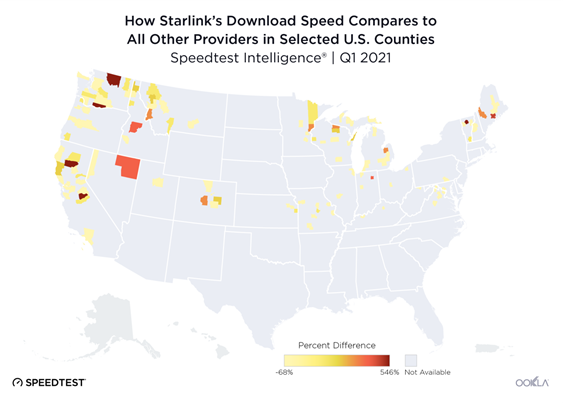
Starlink Shows Tighter Speed Range In Canada
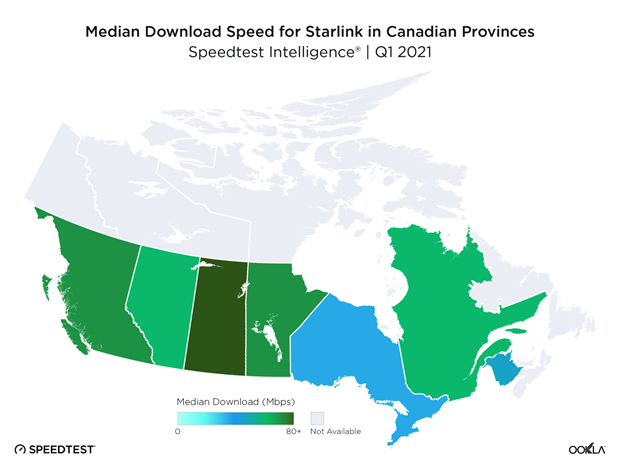
Starlink's average download speed for the first quarter of 2021 in the provinces of Canada was lower than in the US, with a minimum of 53.61 Mbps in Ontario and a maximum of 80.57 Mbps in Saskatchewan. The percentage difference compared to all other fixed broadband providers also showed a smaller gap. In Saskatchewan and Manitoba, Starlink customers reported an average download speed of 59.6% and 38.5% higher than all other fixed broadband providers combined. In Quebec, the median download speed was almost the same, with Starlink running only 3.4% slower. In British Columbia, Alberta, Ontario, and New Brunswick, on the other hand, Starlink median download speeds were 20.9%, 24.2%, 29.5%, and 40.7% lower than other fixed broadband providers. ...
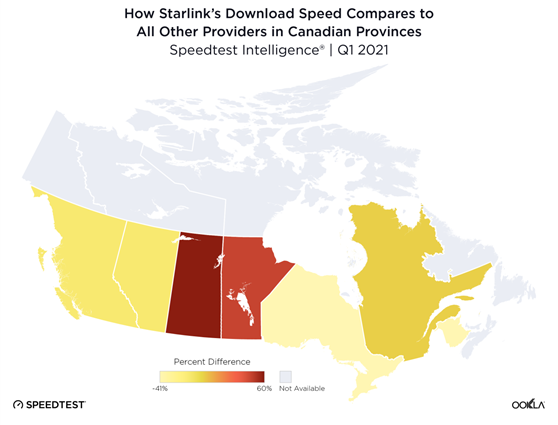
Starlink latency 486% higher in the US, 369% higher in Canada
Low latency is critical to efficient use of the Internet. If your latency is too long, you may be participating in a pewter-voice video call that is still answering the question when the conversation has already ended. Starlink plans to use low-earth orbit satellites with laser links to drastically reduce waiting times in rural areas. But so far we can see that Starlink latency is higher than that of alternative providers (often much higher).
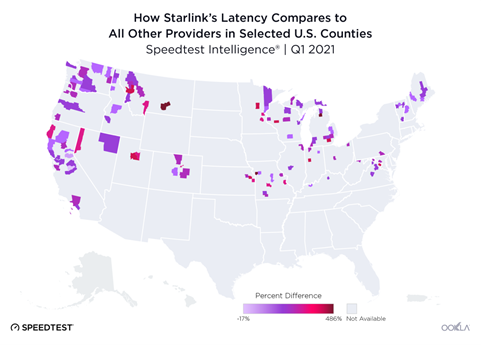
In the first quarter of 2021, Starlink latency was higher in all but one US counties. The exception was Mariposa County, California, where Starlink latency was 17.4% lower than all other providers combined. Average latency values on Starlink ranged from 31ms (Kittitas County, Washington) to 88ms (Otsego County, Michigan). In comparison, the average latency for all other providers combined ranged from 8ms (Fairfax County, VA) to 47ms (Davis County, Kentucky).
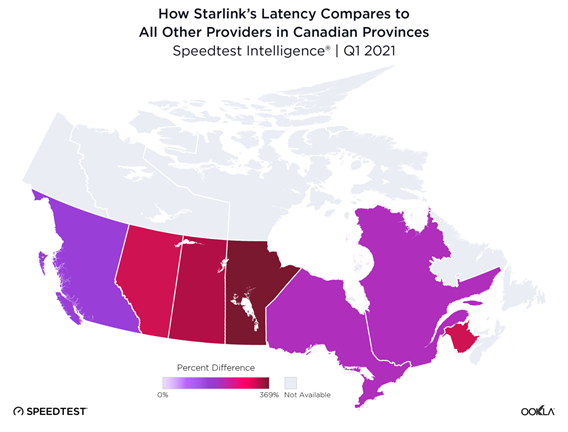
In Canada, Starlink latency was higher in all provinces surveyed during the first quarter of 2021. With latency averages ranging from 34ms (BC) to 61ms (Saskatchewan), Starlink latency was 209.1% - 369.2% higher than all other providers combined.
Starlink meets the minimum level for the FCC Rural Opportunity Fund
To compete for the FCC's Digital Rural Development Fund (RDOF) , providers must meet a minimum performance level (25 Mbps to subscriber, 3 Mbps to subscriber, 100ms latency). We analyzed the Speedtest results for users with more than two tests during the first quarter of 2021 to see if Starlink could potentially qualify for this funding.
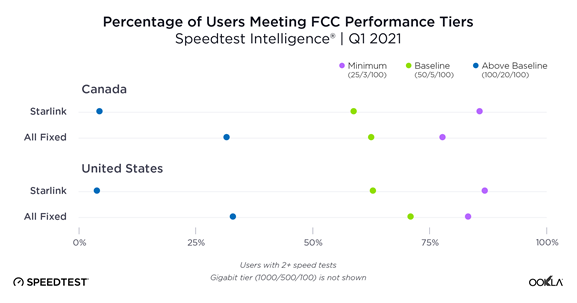
In both the US and Canada, Starlink provided competitive or superior services at a minimum (25/3/100). In the US, 86.7% of Starlink users have reached this threshold, compared with 83.2% of all other fixed broadband providers. While FCC criteria do not apply north of the border, 85.6% of Canadian Starlink users hit the minimum threshold, compared to 77.8% for all other providers. Starlink has a lower share of baseline users and higher than all other providers combined.
Given this data, it's safe to say that Starlink could be a cost-effective solution that will dramatically improve broadband access in rural areas without the need to run thousands of miles of fiber.
The Starlink Mask experiment is certainly fun, and we welcome any effort to improve service to the villagers. However, these are clearly the first steps for Starlink. We'll be monitoring how performance improves as more satellites are launched and more users connect to the service.
So, we can confidently say that for many rural areas in the US, StarLink is a great solution, providing many times faster Internet. However, in competition with modern optics and LTE / 5G technologies, StarLink is not competitive.
The StarLink service is currently characterized by the instability of the speed and delay in the channel, which can be attributed to the small number of working satellites.
Since the question is, how many satellites will be needed in order for average speeds to approach the level of 100 Mbit for injection (and this is the speed that SpaceX announced at the RDOF competition (for more details about this program and SpaceX's participation in it - https: // habr.com/ru/post/541234 and for which he won lots totaling $ 885 million).
Also, one cannot fail to note the following very alarming factor, as of March-April 2021 at least 800 StarLink satellites launched no later than October 24, 2020, or 50% of the number of satellites of the first stage (1584 satellites), or approximately 20% of the number of satellites in the Ku-range. At the same time, the number of subscribers did not exceed most likely 30-40 thousand (10,000 subscribers were reported in February). As we can see, from the first picture we will repeat it here:
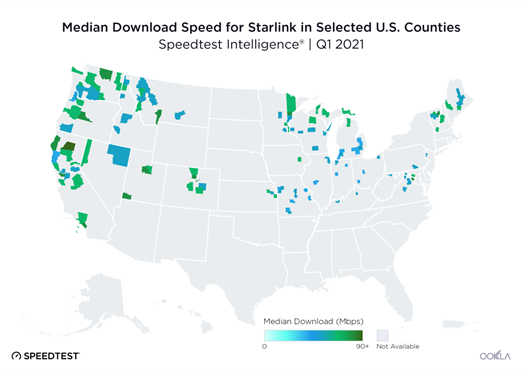
The StarLink service is still available (concentrated) in a fraction of the US territory (it should be noted that the figure shows counties, sometimes thousands of square kilometers in area, and the service is provided in cells with an area of no more than 500 square kilometers (diameter 14 miles), that is the area of the operating service is even smaller.This raises the question of the real performance (or throughput) of each satellite, and how much it differs from 17-23 Gbit / s, declared 5 years ago, which most directly affects the economy of this project, since the entire the satellite constellation must be renewed every 5 years.
The second unpleasant aspect of this report is that if a different provider comes to today's StarLink subscriber in the future, then its optics or 5G technology will have better technical characteristics, and accordingly, the outflow of StarLink subscribers to wired and wireless operators is likely to be very large in the future.